 |
A Branch of the Jarvis Family
Janet Robinson
8. People mentioned in the Will of Dr. Daniel Jarvis in the order in which they appear (if anything known)
JOSHUA WADDINGTON
Joshua was the son of Daniel's sister Sarah, who married Samuel Ferrand Waddington in 1788, (see separate history for further information on Samuel). He was born in 1793 in Clapham, Surrey. According to ‘Historic Margate’ by G. Clarke, Joshua came to Margate in about 1804 to live with his uncle, who had him educated and paid for him to be trained as a doctor at Guys hospital. We know that Joshua’s father, Samuel, was declared bankrupt at this time. On qualifying as a doctor Joshua returned to Margate to join his uncles practise in Cecil Square, and eventually took it over when Daniel had to retire for health reasons.
Joshua was one of the physicians on the staff of the Royal Sea Bathing Infirmary. He was the champion of the poor and ill used, and tried to put right what he believed to be wrong. G. Clarke’s book states: - Mr. F.W. Cobb, the famous deputy of Margate, Mr Stephen Sackett Chancellor, a baker of Margate, who filled the posts of collector of the droits of the pier, and clerk of the directors of the pier, and of collector of the Queen’s taxes, and many others, found in him a redoubtable antagonist.
A fine, tall man, of commanding presence, Waddington became a popular hero among his followers. Striking his well-known attitude, he would address his hearers in such a manner as to leave the impression on their minds that he was invincible. He did not know what fear was. But the worthy well-meaning doctor – like other people – occasionally made mistakes. One of the worst of these was his opposition to the South Eastern Railway scheme, more especially the branch line from Ramsgate.
Joshua Waddington married twice. His first wife was Maria Collard, and they married in 1823 at Minster, nr. Ramsgate. They had two sons, the first John Jarvis Waddington, was born at Margate in 1824 and buried at Margate in 1851, the second, Herbert Waddington, born in Margate in1827 entered the church and became rector of Ranmore.
Joshua’s second wife was Anne Isabella Reynolds and they married in London in 1835. They also had two sons, Joshua born at Margate in 1836 and buried at Minster in 1883, and Edmund Cosworth Waddington who was born at Margate in 1837.
Joshua died in 1859 and was buried at Minster.
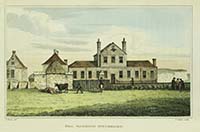 |
Sea Bathing Infirmary |
STEPHEN SACKETT CHANCELLOR
The second of Daniel’s trustees was Stephen Sackett Chancellor. Stephen was a baker in Margate who supplied the Sea Bathing Infirmary with bread, but on one occasion he was accused of supplying underweight goods. He was also the collector of droits on the pier, a collector of the Queen’s taxes, and a clerk to the directors of the pier.
In 1817 Stephen was involved in a slander case where his description was given as usually wearing a fustian jacket and waistcoat, corded breeches, and cloth or fustian whole leggings. (Fustian was a thick-twilled cotton cloth, usually dyed a dark colour).
EDWARD WADDINGTON
Another of Daniel’s nephews, Edward Waddington, was the third trustee. In the will he is mentioned as being a surveyor at Seven Oaks. All I know about him is that he married and moved to Jersey, where he died in 1880.
NATIONAL SCHOOL AT MARGATE
This school was in Mill Lane at Margate.
PHILOSOPHICAL INSTITUTE AT CANTERBURY
The Philosophical Institution was situated in Guildhall Street at Canterbury, and was established in 1825 by subscription. It consisted of a library, an extensive museum of natural and artificial curiosities, chiefly illustrative of natural history, and a lecture room capable of holding about a hundred people.
The foundation stone was laid on 28th June 1823.
In 1898 it moved to the Beaney Institute.
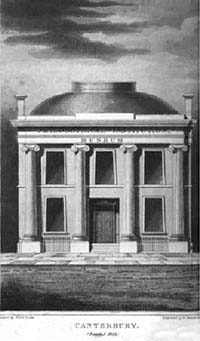 |
Canterbury Philosophical Institute |
SOCIETY FOR THE PROMOTION OF CHRISTIAN KNOWLEDGE
On 8th March 1698 a group of five friends met at Lincoln's Inn to prepare for the departure of one of their number for America. Thomas Bray, an Anglican priest, was to visit the colony of Maryland on behalf of the Bishop of London. Not knowing how long he would be away, the friends resolved to form a society to ensure that the many good works with which he was involved could continue in his absence.
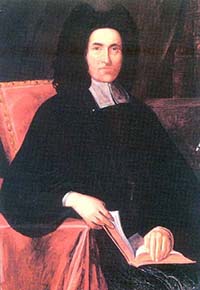 |
Thomas Bray |
The primary concern of the Society's founders was to "counteract the growth of vice and immorality", which they ascribed to "gross ignorance of the principles of the Christian religion". The main ways in which they felt the situation could be tackled were through encouraging education and the production and distribution of Christian literature. Through the work of SPCK, they hoped to build up a more learned clergy and to find ways of communicating the basic principles of the Christian faith to a wider audience, both in Britain and overseas.
In the event Bray only stayed in Maryland for a few months, but the Society for Promoting Christian Knowledge which was formed that day is still active over three hundred years later. Over the years, SPCK has distributed over 30 million books and has provided the means for translating the Book of Common Prayer into more than 200 languages. SPCK sent the first printing presses to India, opened the first British schools for poor children, gave equal education to girls, sent the first printed books to Australia, established libraries for clergy and missionaries in many countries, and published the first Braille books.
Thomas Bray believed passionately In the power of the printed word. At the Society's second meeting, it was decided to print and distribute "Mr Keith's Narrative and Catechism". Since then SPCK has been continuously active as a publisher, making it the third oldest English publishing house still operating today. Throughout the eighteenth century SPCK was by far the largest producer of Christian literature in Britain. The range of its output was considerable - from pamphlets aimed at specific groups such as farmers, prisoners, soldiers, seamen, servants and slave-owners, exhorting them to improve their way of life, to more general works on subjects such as baptism, confirmation, Holy Communion, the Prayer Book and private devotion.
Throughout the eighteenth century SPCK was also the catalyst for the spectacular growth of the charity school movement. The Society provided advice and encouragement to local groups to help them set up, finance and run many hundreds of schools. Although it had no formal authority, SPCK was widely regarded as the chief point of reference for all charity schools, producing model sets of rules, and providing a curriculum and examples of good practice for teachers and trustees establishing new schools. It was also responsible for setting up similar schools in America.
THE THEATRICAL FUND SOCIETY IN LONDON
We know that Daniel was very interested in the theatre, and was known to take part in productions at the Theatre Royal in Margate, and he bequeathed one hundred pounds to this association.
It was a benevolent fund established ‘for the relief and support of such performers and other persons belonging to the theatre, as, through age, infirmity, or accident, should be obliged to retire from the stage.’
THE PHILANTHROPIC INSTITUTION OF MARGATE
The Philanthropic Institute used to meet at the Fountain Inn every Tuesday evening. Its object was to afford temporary relief to the poor of Margate during the winter months. During the winter of 1823 the society distributed 795 quarterns of loaves (a quartern was a four pound loaf), 640lbs of meat and 610 bushels of coal.
LYING-IN CHARITY OF MARGATE
This charity was to provide aid to the poor women of the town during childbirth.
MARY ANN ORNSBY
Mary Anne was the daughter of Daniel’s sister Maria Ann (Bradbridge)
ELIZABETH HIRT
Elizabeth was another daughter of Daniel’s sister Maria Ann (Bradbridge)
ANNETTE SURMAN AND HENRY SURMAN
In Daniel’s will these two are listed as a niece and nephew. At the moment I do not know the exact relationship.
MARY OAKLEY
Daniel’s mother before her marriage was Anne Oakley, so this cousin Mary would be from this side of the family
JAMES, JOHN AND JEREMIAH STRANACK
These three cousins were the children of Daniel’s aunt Priscilla Stranack (nee Jarvis). They were all mariners.
DAVID HOLNESS
David was the son of Daniel’s aunt Anna Holness (nee Jarvis). He was a hairdresser in King Street, Margate.
ROBERT SALTER
In a directory for 1796 Robert is listed as having a grocers shop in Market Street. In 1801 his business is listed as a house, tallow house, store house and store in market Street, with a house, coach house and stable in Newby’s Yard. He was chairman of the Philanthropic Institute.
JAMES MICKLEBURGH
Thanet House Academy was established in Charlotte Square in 1808 by James Mickleburgh. In 1811 he moved the school to St. Peter’s Footpath. James died in 1859 at the age of 81.
In 1901 the school, now called Thanet College, moved to more up-to-date premises in St. Peter’s Footpath.
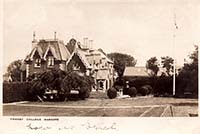 |
Thanet College Margate 1904 |
WILLIAM EDMUNDS
William Edmunds was the distinguished Margate surveyor and architect, responsible for the design and building of Holy Trinity Church, the 1829 lighthouse on Margate pier, Levy’s bazaar in the High street, and the Droit House. He also designed Trinity Church at Dover. William died in 1847, at the early age of 46, in Peckham Lunatic Asylum.
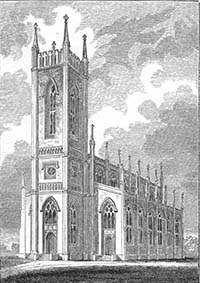 |
Holy Trinity Church |
FRANCES REYNOLDS
Frances Reynolds ran Gordon House Seminary, a girl’s boarding school, in Churchfields Place, Margate.
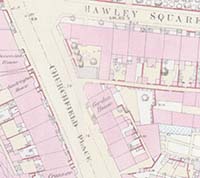 |
Gordon House Seminary in Churchfields Place |
CATHERINE HOWE
Catherine Howe was the daughter of Francis Howe who in 1810 began his long association with the Assembly Rooms and Royal Hotel in Cecil Square, which became known as Howe’s Royal Hotel. He went bankrupt in 1835.
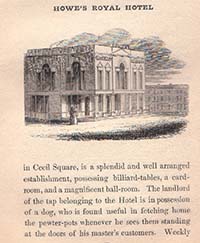 |
Howe's Royal Hotel |
ELIZA TADHUNTER
Eliza was a widow who ran a lodging house in Lower Marine Terrace.
REVEREND WILLIAM FREDERICK BAYLEY
Rev. Bayley was Vicar of St. Johns church from 1810 to 1844. It was his drive and initiative which led to the building of the new Holy Trinity church in Cliftonville. He was also Prebendary (honorary canon) of Canterbury and Rochester
JAMES TAYLOR
The bequest to the convict James Taylor is an interesting one. He was found guilty of being involved with the 1821 battle of Marsh Bay and sentenced to deportation, but many local people – including it seems Daniel Jarvis – thought him innocent, and a fund was set up to help him and his family. The attached article appeared in the Margate Historical Magazine of November 2003.
MRS MARGARET FORSTER
Margaret was the wife of Francis Forster. The following information was taken from G. Clarke’s ‘History of Margate’ : - Somewhere near the close of the 18th century a man of eccentric habits, named Francis Forster, came to live in Margate, building a large red brick house which he called Northumberland House. In or about the year 1798 his gardener, digging behind the house, made the discovery of the Vortigern Caves.
MR J E WRIGHT
This was James Edward Wright, solicitor of 36 Hawley Square.
SIR RICHARD BURTON
Sir Richard Burtn lived at Sackett’s Hill, St. Peters.
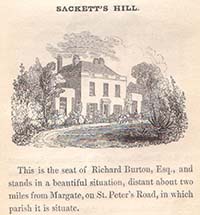 |
Sackett's Hill |
FRANCIS WILLIAM COBB AND WILLIAM COBB
The Cobb family were very important in the history of Margate, opening a brewery, and their own bank, being involved with Margate Pier and Harbour Company and various societies in the town.
J. CRAMP ESQ.
John Cramp farmed at Garlinge. This quote is from Kidd’s guide: - here is a large farm belonging to Bethlem Hospital, London, and therefore called Bethlem Farm, occupied by that very intelligent and public-spirited individual, John Cramp, Esq.
WILLIAM BROOK
William Brook was a solicitor and notary of 12 Cecil Square.
The following property auction advertisement was in various Kent newspapers for several weeks before the actual auction on the 9th January 1834, and gives details of the properties owned by Daniel Jarvis. His house in Marine Gardens was given to his nephew Joshua Waddington.
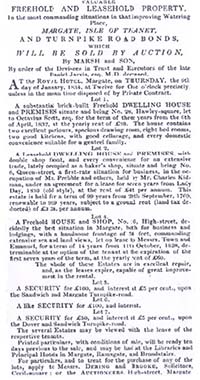 |
Advertisement for sale of Jarvis property 1834 |